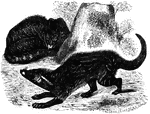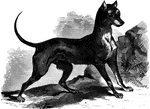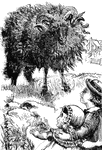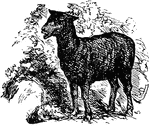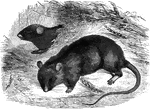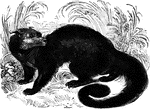
Black Binturong
"Of this genus, there is only one species, the Black Ictide. Colored black with speckles of…
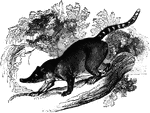
Coati Mondi
"They are distinguished by a long body, a long head terminating in a long flexible snout, with which…
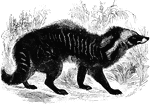
Civet
"Of this genus there are two species. The length of the elongated body of his animal is from two to…

Pougonie
"P. typus, is of a yellowish brown, marked with three ranges of obscure spots on the back.;…
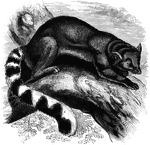
Ring-Tailed Bassaris
"It has a sharp, pointed nose, and a cunning expression, reminding one of a fox or raccoon. The body…
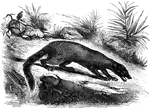
Galidia
"Of a lively russet, spotted with brown and olive, the tail being annulated with black. It is ten inches…
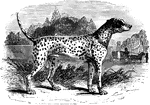
Dalmatian
"Its body is generally white, marked with numerous small round black, or reddish-brown spots. The dalmatian…
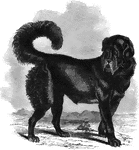
Thibet Masiff
"The thibet mastiff is of immense size, and of a deep-black color, slightly clouded on the sides, his…
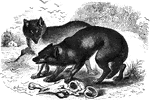
French Wolves
"The common wolf is of the size of a large dog; its usual color is a yelowish gray: the hair strong…

American Wolf
"The common wolf is of the size of a large dog; its usual color is a yelowish gray: the hair strong…
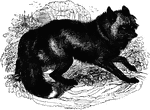
American Cross Fox
"The size is that of the common fox, the fur exceedingly long, soft, and rich; and, although presenting…
!["A detachment of the First South Carolina [African American] Federal Volunteers, under the command of Colonel Beard, repelling the attack of Confederate troops in the vicinity of Doboy River, GA." —Leslie, 1896](https://etc.usf.edu/clipart/11200/11251/doboy_11251_mth.gif)
Doboy River
"A detachment of the First South Carolina [African American] Federal Volunteers, under the command of…

Destruction of Merrimac
"Destruction of the Confederate ironclad steamer Merrimac, blown up by its commander, on the…

Caffre Cat
"F. Caffra , is about two feet long; its tail is long and bushy; its ground-color and of a…
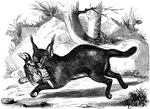
Caracal
"The Caracal, or Siyah Ghush, F. Caracal, is supposed by some to be the lynx of the ancients.…

Steamer Alabama
"The Confederate privateer steamer Alabama (290). Captain Raphael Semmes. Our illustration…
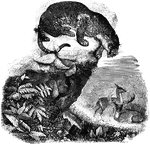
Jaguar
"Its length is four to five feet; the tail two feet; the height two feet; the ground-color of the body…

Cheetah
"In size and shape it is between the leopard and the hound. The color is yellowish fawn above, ad nearly…

Cape Ratel
"The hair is stiff and wiry; body above, from the top of the head to the root of the tail, dull ash-gray,…
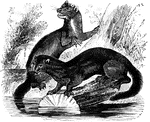
Mink
"The mink has a long slender body, the color varying in different species, is generally dark brown,…

Malabar Squirrel
"The largest species of the genus, being the size of a cat. A part of the body above is brilliant red…

Black Agouti
"Is considerably smaller than the common agouti, being about the size of a rabbit, while the species…

Cuvier's Lagotis
"Its general appearance reminds one of the hare. The body above is yellow, with a faint tinge of green…
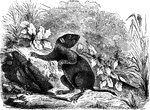
Black Pephagomys
"This is five inches long, of a black color, and has nearly naked ears; it feeds on vegetable substances,…
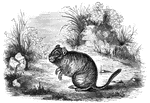
Octodon
"In size and shape, it resembles the water rat. The fur is long and moderately soft; upper parts of…

Battle of Baker's Creek
"Battle of Baker's Creek, May 16th, 1862- Defeat of the Confederates under Pemberton, by General Grant.…
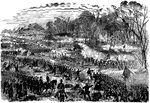
Battle of Champion Hills
"Battle of Champion Hills, May 16th, 1863- the formidable position of General Pemberton carried by Generals…

War in Mississippi
"The war in Mississippi. General McPherson's army crossing the Big Black at messenger's Ferry, Thursday,…

Dutch Gap Canal
"Blowing out of the bulkhead of the Dutch Gap Canal, James River, Va., January 1st, 1865. At twelve…
!["Siege of Petersburg. The [African American] infantry bringing in captured guns and cheers of the Ohio troops. When the [African American] troops found themselves within the works of the enemy no words could paint their delight. Numbers of them kissed the guns they had captured with extravagant satisfaction, and a feverish anxiety was minfested to get ahead and charge some more of the Confederate works. A number of the [African American] troops were wounded and a few killed in the first charge. A large crowd congregated, with looks of unutterable admiration, about Sergeant Richardson and Corporal Wobey, of the Twenty-second United States [African American] regiment, who had carried the colors of their regiment and been the first men in the works. Our artist gives a sketch of this gallant action."— Frank Leslie, 1896](https://etc.usf.edu/clipart/11800/11801/petersburg_11801_mth.gif)
Siege of Petersburg
"Siege of Petersburg. The [African American] infantry bringing in captured guns and cheers of the Ohio…
!["Assault of the Second Louisiana [African American] Regiment on the Confederate works at Fort Hudson, May 27th, 1863. The Battle of Fort Hudson was a severe and well-fought action. The Federal troops displayed their usual bravery, and were well handled by General Banks, driving the enemy to his second line of works. Of the [African American] regiments General Banks, in his official report, says: 'They answered every expectation. Their conduct was heroic. No troops could be more determined or more daring. They made during the day three charges upon the batteries of the enemy, suffering very heavy losses, and holding their position at nightfall with the other troops on the right of our line. The highest commendation is bestowed upon them by all officers in command on the right. Whatever doubt may have existed heretofore as to the efficiency of organizations of this character, the history of this day proves conclusively to those who were in a condition to observe the conduct of these regiments that the Government will find in this class of troops effective supporters and defenders. The severe test to which they were subjected, and the determined manner with which they encountered the enemy leave upon my mind no doubt of their ultimate success. They require only good officers, commands of limited numbers, and careful discipline to make them excellent soldiers.'"— Frank Leslie, 1896](https://etc.usf.edu/clipart/11800/11805/ft-hudson_11805_mth.gif)
Fort Hudson
"Assault of the Second Louisiana [African American] Regiment on the Confederate works at Fort Hudson,…
!["Siege of Petersburg- the Ninth Corps charging on the enemy's works after the explosion of the mine, July 30th, 1864. Immediately after the explosion of the mine a hundred cannons opened along the Federal front, and at half-past five the Ninth Corps charged, carrying the fort with a part of the line on each side. The Second Division, which was in the centre, advanced and carried the second line a short distance beyond the fort, and rested, holding ground with the utmost determination. It was at the time the [African American] Division, under General White, was pushed forward and ordered to charge and carry the crest of the hill, which would have decided the contest. The troops advanced in good order as far as the first line, where they received a galling fire, which checked them, and although quite a number kept on advancing, the greater number seemed to become utterly demoralized, part taking refuge in the fort, and the remainder running to the rear as fast as possible. They were rallied and again pushed forward, but without success, the greater part of the officers being killed or wounded."— Frank Leslie, 1896](https://etc.usf.edu/clipart/11800/11856/petersburg_11856_mth.gif)
Siege of Petersburg
"Siege of Petersburg- the Ninth Corps charging on the enemy's works after the explosion of the mine,…

General Joseph E. Johnston
"General Johnston, born in Cherry Grove, near Farmville, Va., February 3rd, 1807; died at Washington,…
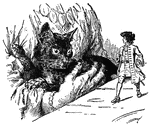
Gulliver and Giant Cat
Gulliver on a dinning table, with the giants of Brobdingnag, looking at a very large cat.

Grove of black-locust trees
A grove of black-locust trees. Contrast with the brush in the background on an adjoining farm.
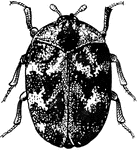
Adult Common Carpet Beetle
An adult common carpet beetle, a small grayish or black beetle belonging to the order Coleoptera.

Common Carpet Beetle Pupa
Pupa of the common carpet beetle, a small grayish or black beetle belonging to the order Coleoptera.

Common Carpet Beetle Larva
Larva of the common carpet beetle, a small grayish or black beetle belonging to the order Coleoptera.

Common Carpet Beetle Larva
Larva of the common carpet beetle, a small grayish or black beetle belonging to the order Coleoptera.

Fork-Tailed Kite
"The fork-tailed kite, (N. furcatus) is twenty-five inches long; the wings and tail black;…

Goshawk
"The American goshawk &mdash the black-cap haw of Wilson &mdash A. atricapillus which has been…
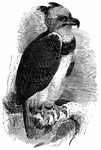
Harpy Eagle
Genus Harpyia, it is one of the largest, most fierce, and powerful eagles. It has a crest of…
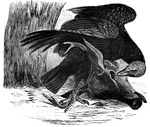
Black Vulture
Genus Coragyps, about the size of a small turkey. This one is feeding on a cow's head.
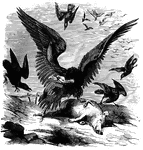
Black Vulture
Black vulture (or carrion crow), genus Coragyps, about the size of a small turkey. This group…

Black-Banded Dacelo
The black-banded dacelo, found around the Cape of Good Hope. They are known for feeding on earthworms,…
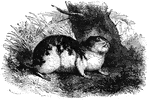
Lapland Lemming
"Of the Lemming genus, the Lapland Lemming is the most celebrated which is confined to Lapland and Norway.…
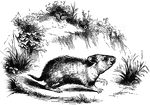
Hamster
It is a reddish-brown color above and black below, but variations in color ar enot uncommon. The length…

Sminthus Loriger
"Two and a half inches long, with a tail of nearly equal length. It is of a grayish-brown, with a black…

Barbary Mouse
"It is of a grayish-fawn color, with ten longitudinal brown strips along the back. Between the size…
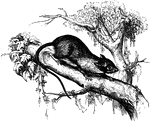
Free Mouse
Dendromys Typicus. "Size of the common mice, and are of a pearly-gray color, and have a black band running…

